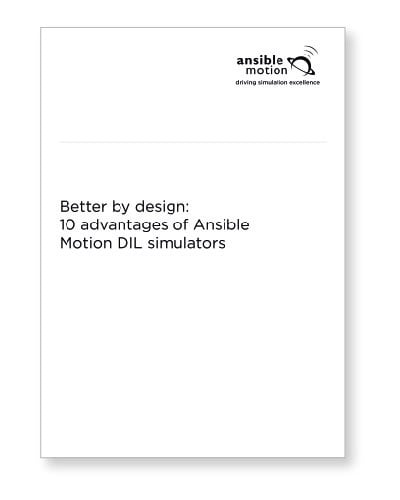 Applied Ergonomics has published new research findings regarding the use of full motion driving simulators for autonomous car sickness studies. This collaborative research project was conducted by VU University's Department of Behavioral and Movement Sciences, TNO's Department of Perceptual and Cognitive Systems, Coventry University's Centre for Mobility and Transport, and Ansible Motion.
Applied Ergonomics has published new research findings regarding the use of full motion driving simulators for autonomous car sickness studies. This collaborative research project was conducted by VU University's Department of Behavioral and Movement Sciences, TNO's Department of Perceptual and Cognitive Systems, Coventry University's Centre for Mobility and Transport, and Ansible Motion.
Specifically, the following question is addressed: Can motion base driving simulators, in principle, be used to induce motion sickness analogous to carsickness via cued motions inside specific frequency regions?
Abstract
We investigated whether motion sickness analogous to carsickness can be studied in moving base simulators, despite the limited motion envelopes. Importantly, to avoid simulator sickness, vision outside the simulator cabin was restricted. Participants (N = 16) were exposed blindfolded to 15-min lateral sinusoidal motion at 0.2 Hz and 0.35 Hz on separate days. These conditions were selected to realize optimal provocativeness of the stimulus given the simulator's maximum displacement and knowledge on frequency-acceleration interactions for motion sickness. Average motion sickness on an 11-point scale was 2.21 ± 1.97 for 0.2 Hz and 1.93 ± 1.94 for 0.35 Hz. The motion sickness increase over time was comparable to that found in studies using actual vehicles. We argue that motion base simulators can be used to incite motion sickness analogous to carsickness, provided considerable restrictions on vision. Future research on carsickness, potentially more prevalent in autonomous vehicles, could benefit from employing simulators.
Highlights
- Can car sickness be studied in simulators, despite limited motion envelopes?
- Can motion frequencies causing car sickness can be re-created with a driving simulator?
- Does vision restriction influence simulator sickness?
- Does motion sickness in driving simulators occur at a similar rate as in actual vehicles?
- Are moving base driving simulators useful for autonomous car experiments and studies?
Ansible Motion, as co-author of this article, is happy to offer a limited-time Share Link on Science Direct that provides free access and download privileges for this article. Before September 06, 2019, there are no sign-up or registration fees for using this link.
If you would like to learn about driving simulator technology in general, we invite you to download the free white paper titled "Driving Simulator Technology and How Automotive Manufacturers Will Benefit."



